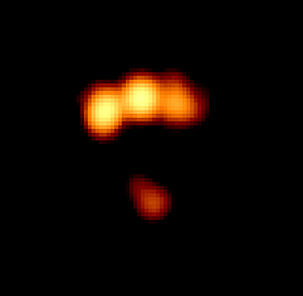Playing it Safe: Chandra's Return to Science Observations

Credit: NASA/CXC/Trinity University/D. Pooley et al.
On October 10th, NASA’s Chandra X-ray Observatory went into “safe mode,” following a glitch on one of the telescope’s gyroscopes. After hard work by the team at the Chandra X-ray Center, the problem was identified and solved, allowed Chandra to resume science observations less than two weeks later on October 21st.
One of the first targets that Chandra looked at after its return to science was PS 0147+4630, a gravitationally-lensed quasar. What is that exactly? A quasar is a supermassive black hole that is rapidly consuming gas from its surroundings. The gas falls into a disk around the black hole where it becomes hot and generates prodigious amounts of radiation. Gravitational lensing is a phenomenon, first predicted by Einstein, where light from a very distant source is bent by a massive intervening object, such as a large galaxy or a galaxy cluster. This creates multiple images of a single, faraway object and amplifies the brightness of the light, acting in some ways as a natural magnifying glass.
The brand new Chandra image shows four separate X-ray sources corresponding to PS 01247+4630, located 10.9 billion light years from Earth (the galaxy responsible for the gravitational lensing is 5.6 billion light years from Earth). The image is only three arcseconds across, where one arcsecond is the apparent size of a penny seen at a distance of 4 km (2.5 miles). Chandra is the only X-ray telescope with high enough resolution to separate these sources from one another.

Dave Pooley
Astronomers Dave Pooley (Trinity University, San Antonio, Texas) and Paul Schecter (Massachusetts Institute of Technology) proposed to look at this system as part of a larger observing program that will study several of these gravitationally-lensed systems, including other quadruple lenses and even a quintet. The goal of this project is to study the disks of material that swirl around and feed the quasar’s black holes, as well as determine how much dark matter is contained in the galaxies that are acting as lenses.
While the safe mode from this month was a concern, the scientists, engineers, and other professionals at the Chandra X-ray Center were ready. However, it does remind us that conducting science in space is difficult – especially after a telescope has been in space for over 19 years as Chandra has been!
Although Chandra has gone into safe mode before in its nearly two decades of observations, this was the first time that a gyroscope was involved. For now, Chandra will operate with a different configuration of its four gyroscopes as the gyroscope with the glitch is currently in reserve.
Please note this is a moderated blog. No pornography, spam, profanity or discriminatory remarks are allowed. No personal attacks are allowed. Users should stay on topic to keep it relevant for the readers.
Read the privacy statement
